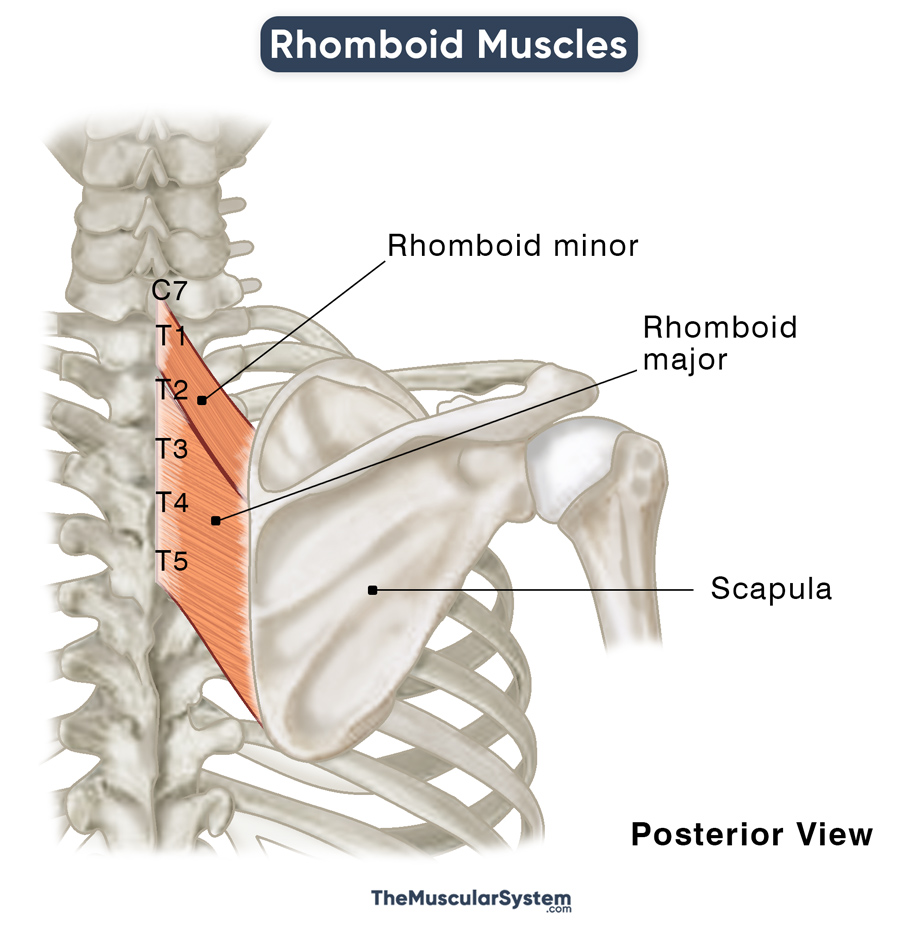Rhomboids
Last updated:
21/10/2024Della Barnes, an MS Anatomy graduate, blends medical research with accessible writing, simplifying complex anatomy for a better understanding and appreciation of human anatomy.
Two paired muscles in the upper back region, rhomboids major and minor, are collectively referred to as the rhomboids. Together, these muscles help in shoulder and upper arm movements. They are located between the two scapula or shoulder blades and belong to the superficial extrinsic back muscle group. Other muscles in the group are the trapezius, latissimus dorsi, and levator scapulae.
Anatomy
| Muscle | Origin | Insertion | Innervation | Blood Supply |
| Rhomboid major | Spinous processes of T2 to T5 vertebrae | Medial border of the scapula | Dorsal scapular nerve (C4, C5) | Dorsal scapular artery |
| Rhomboid minor | Spinous processes of C7 and T1 vertebrae; The nuchal ligament | Medial border of the scapula | Dorsal scapular nerve (C4, C5) | Dorsal scapular artery |
The rhomboids form two parallel bands of muscle, originating from the spinous processes of the 7th cervical vertebra and the 1st to 5th thoracic vertebrae. The rhomboid major originates from just below the rhomboid minor.
Similarly, both muscles insert into the medial border of the scapula, with the rhomboid major’s insertion point just below that of the rhomboid minor.
Relations With Surrounding Muscles and Structures
Both muscles lie deep to and entirely covered by the trapezius muscle, except the adjacent border of the triangle of auscultation that lies inferior to the rhomboid major.
Anatomical Variation
There are typically no variations of the rhomboids, except the two muscles being fused instead of staying as separate muscles. In some instances, the rhomboid minor may overlap the superior portion of the rhomboid major.
In some rare cases, there may be a third rhomboid muscle present. There have been 3 reported instances where a third rhomboid muscle originated from the occipital bone or the nuchal ligament, running deep to the trapezius before inserting into the scapula, near the attachment of the rhomboid major and minor.
Function
- Retracting the scapula, which means helping it slide upward and inward to rotate the glenoid cavity so the shoulders can drop.
- Stabilizing the scapula in place so it can work as an anchor for the rest of the shoulder and upper arm muscles as they work to move the arm.
- Helping maintain posture when standing, walking, or sitting by keeping the scapula in place and preventing it from moving too far from the spine (scapular protraction).
The serratus anterior muscle acts as the primary antagonist to both the rhomboids.
References
- Anatomy, Back, Rhomboid Muscles: NCBI.NLM.NIH.gov
- Rhomboid muscles: KenHub.com
- Rhomboid Major And Minor: Rad.Washington.edu
- Rhomboids: WheelessOnline.com
Della Barnes, an MS Anatomy graduate, blends medical research with accessible writing, simplifying complex anatomy for a better understanding and appreciation of human anatomy.
- Latest Posts by Della Barnes, MS Anatomy
-
Pharyngeal Muscles
- -
Salpingopharyngeus
- -
Stylopharyngeus
- All Posts






